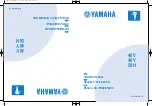
Chapter 3: Architecture
26
Each timer can be used for internal or external clocking and
can interrupt the on-board DSP after a specified number of
events (clocks) or signal an external device after counting
internal events. Each timer can also be used to trigger DMA
transfers after a specified number of events (clocks) have
occurred. Each timer connects to the external world through
one bi-directional pin TIO that is 7kV ESD protected. When
TIO is configured as input the timer functions as an external
event counter or can measure external pulse width/signal
period. When TIO is used as output, it functions as a timer,
watchdog or Pulse Width Modulator.
Some common timer/counter/output functions that
microprocessors require are:
Real time clock,
Event counter
Digital one-shot
Programmable rate generator
Square wave generator
Binary rate multiplier
Complex digital wave form generator
Complex motor control
Note Each counter is a 24-bit count-up counter
After power-up, the count value and output of all counters
are set to zero
Each counter must be programmed before it can be used
Unused counters need not to be programmed
Use the PowerDAQ API to program counters.
Each counter is fully independent of the others. Only
prescaler, when used, is a common part of the counter-timer
subsystem. Each counter may operate in a different mode
Содержание PowerDAQ PDXI-AO Series
Страница 9: ...1 1 Introduction...
Страница 15: ...7 2 Installation and Configuration...
Страница 26: ...Chapter 2 Installation and Configuration 18...
Страница 27: ...19 3 Architecture...
Страница 38: ...Chapter 3 Architecture 30...
Страница 39: ...31 4 API and Third Party Software Examples...
Страница 43: ...35 5 Interconnections...
















































